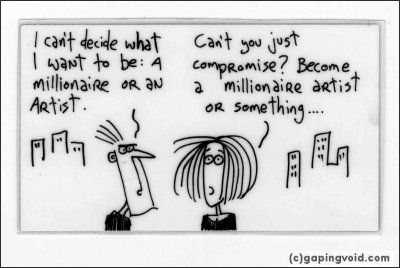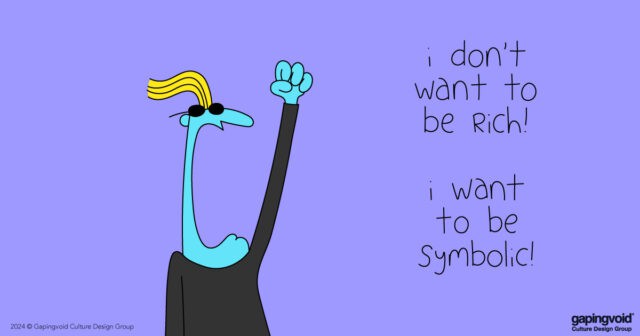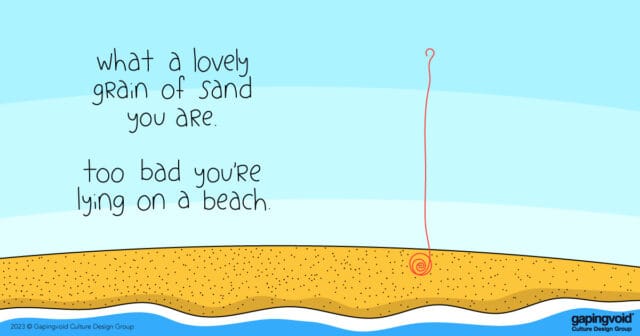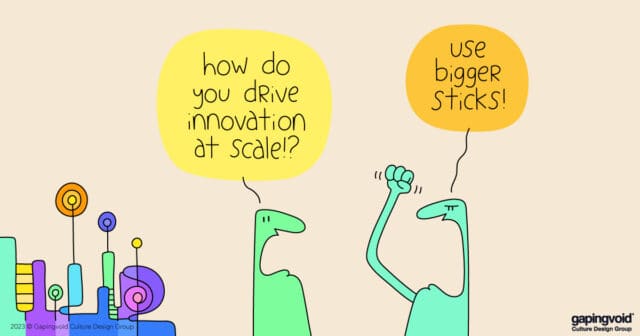THOUGHTS ON “IGNORE EVERYBODY”, EIGHT YEARS LATER
In 2009, my first book, IGNORE EVERYBODY was published by Penguin Portfolio, the big New York imprint. The work originally began life five years before that, in Autumn, 2004 as an e-book, “How To Be Creative”, first published on ChangeThis.com. The e-book came out of a series of blog post I had written in the preceding months before that.
BACKSTORY:
“When I first lived in Manhattan in December, 1997 I got into the habit of doodling on the backs of business cards, just to give me something to do while sitting at the bar. The format stuck.”
Penguin Portfolio is the same imprint that’s published business-book rockstars like Seth Godin, Guy Kawasaki and John Batelle. The book went on to become a Wall Street Journal bestseller, and upped my career by a couple of dozen notches.
The premise of the book was simple enough: “So you want to be more creative, in art, in business, whatever. Here are some tips that have worked for me over the years…”
And then I went down my list for the next couple of hundred pages, ticking off as many boxes as I could. A short book with lots of cartoons, a fun read you could get through easily in one sitting.
I hadn’t intended to write a book at first; it came about because my then-boss told me to stop blogging about stuff related to my marketing day job (and what a crappy day job it was) or else he would fire me.
So, forbidden to blog about marketing or advertising (WTF was my boss thinking?) I had to find something else to write about. As I had spent many years as a cartoonist and an advertising creative, I thought I’d share what I had learned along the way. Simple.
Within a matter of weeks “How To Be Creative” became ChangeThis.com’s most downloaded e-book ever. At last count, it was read by more than five million people and if you add the number of people who have read the blog version, maybe double that. This stat alone pretty much landed me the book deal with Portfolio.
If my career ever had a break-out moment, it was that.
EIGHT YEARS LATER, I’m thinking a lot about how much had changed since 2004, how much I’ve changed, how much in that book still holds true, versus how much I might want to change, now that I’m older and wiser.
“GOOD IDEAS HAVE LONELY CHILDHOODS”
“Good ideas have lonely childhoods” was the main thesis of the book, really.
In other words, quoting the book, “The more original your idea is, the less good advice other people will be able to give you.”
Good ideas take a while to nurture, before the world is ready to accept them. So you might as well “Ignore Everybody”, at least to start with, because for the most part, other people’s opinions won’t be that helpful in the beginning.
Some people thought I was just saying, “Ignore Everybody, just do your own thing and don’t give a damn what other people think.” Well, not really (Although there are times when you have to do that). I was more concerned that people understood the “lonely” part as normal, as something to be expected and embraced.
I think this is an important thing to remember, especially for young people just starting out on their career path. It’s easy to get discouraged; it’s easy to quit prematurely; it’s easy to give up on one’s dreams. If I can make quitting slightly harder for someone, I know I’ve done my job.
My other favorite thing to come out of Chapter One was this observation:
“GOOD IDEAS ALTER THE POWER BALANCE IN RELATIONSHIPS, THAT IS WHY GOOD IDEAS ARE ALWAYS INITIALLY RESISTED.”
Very few people willingly give the kind of advice that will compromise their own social advantage over you. Especially good advice. Good ideas change the status quo. People like the status quo. Human beings are messy, even the ones that care about you. Nothing wrong with that, just something to keep in mind.
BESIDES THAT…
I’m pretty happy with the book, overall- I wouldn’t change much. What’s more interesting to me is, of course, the stuff I’ve learned SINCE then.
I read last week somewhere that 89% of phone apps are free, and of the few remaining that aren’t, 90% of those are under three dollars. With Amazon Kindle, e-books, blogging and other formats disrupting the traditional publishing model, I expect the book format to go the same way as the phone app i.e. free or dirt cheap for the vast majority.
A few published authors will get decent royalties- the J.K. Rowlings’ and the Malcolm Gladwell’s of the world- but for us mere mortals, we’ll have to find other business models. I’m totally OK with that. With no desire to write a proper sequel to Ignore Everybody, I thought maybe a little blog post or two would suffice. Hence…. this.
[TO BE CONTINUED…]




